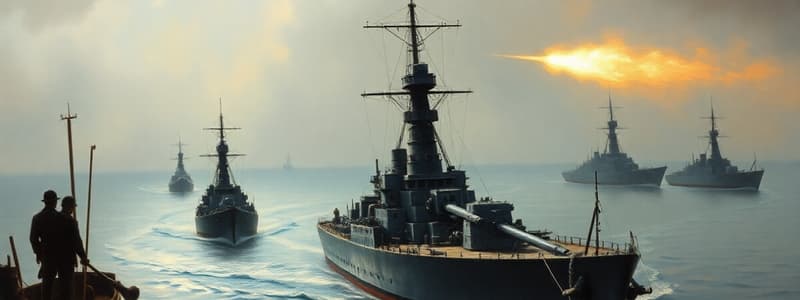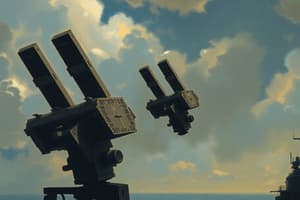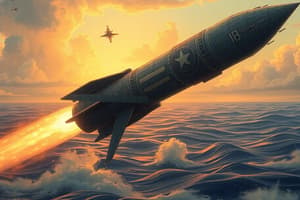Podcast
Questions and Answers
What is the primary function of the Self-Defense Weapons Coordinator in the 'Detect to Engage' mission?
What is the primary function of the Self-Defense Weapons Coordinator in the 'Detect to Engage' mission?
- Report the target's range and bearing to the TAO.
- Designate a target for the Weapons Delivery System. (correct)
- Direct forces and weapons to achieve a mission objective.
- Determine the target's size and shape.
Which of the following weapons systems are primarily used against submarines?
Which of the following weapons systems are primarily used against submarines?
- Harpoon
- ASROC (correct)
- Tomahawk
- Standard missile
Which of these is NOT considered a threat to U.S. ships?
Which of these is NOT considered a threat to U.S. ships?
- Aircraft carrier (correct)
- UAV
- Cyber attacks
- Mine
What does the acronym 'RADAR' stand for?
What does the acronym 'RADAR' stand for?
What type of guidance system does the Tomahawk missile use?
What type of guidance system does the Tomahawk missile use?
Which of the following is NOT a designated warfare area for Fire Control operators?
Which of the following is NOT a designated warfare area for Fire Control operators?
What is the primary function of the 'Naval Surface Fire Support (NSFS)' mission?
What is the primary function of the 'Naval Surface Fire Support (NSFS)' mission?
Which of these is NOT a feature that SONAR can detect?
Which of these is NOT a feature that SONAR can detect?
Which of these factors has the strongest impact on the speed of sound underwater?
Which of these factors has the strongest impact on the speed of sound underwater?
What is the primary purpose of a towed acoustic device used to counter torpedo threats?
What is the primary purpose of a towed acoustic device used to counter torpedo threats?
What does the term "Misfire" refer to in the context of weapon malfunctions?
What does the term "Misfire" refer to in the context of weapon malfunctions?
Which of the following describes the concept of "Train Warning Circle" as applied to weapon safety?
Which of the following describes the concept of "Train Warning Circle" as applied to weapon safety?
What is a key safety concern associated with high-frequency electromagnetic radiation near ordnance?
What is a key safety concern associated with high-frequency electromagnetic radiation near ordnance?
What is the primary function of "Active SONAR" in detecting underwater objects?
What is the primary function of "Active SONAR" in detecting underwater objects?
What is the primary concern associated with the "Hot Gun" phenomenon in weapon systems?
What is the primary concern associated with the "Hot Gun" phenomenon in weapon systems?
What is the difference between "Passive SONAR" and "Active SONAR" in terms of how they detect underwater objects?
What is the difference between "Passive SONAR" and "Active SONAR" in terms of how they detect underwater objects?
Which of the following frequency ranges is associated with Very High Frequency (VHF)?
Which of the following frequency ranges is associated with Very High Frequency (VHF)?
What is the primary purpose of electronic cooling systems in weapon systems?
What is the primary purpose of electronic cooling systems in weapon systems?
What is indicated by blue color coding on ammunition?
What is indicated by blue color coding on ammunition?
Which of the following publications contains information regarding the Combat System Operational Sequencing System (CSOSS)?
Which of the following publications contains information regarding the Combat System Operational Sequencing System (CSOSS)?
What is the purpose of the ship's gyro as it relates to weapon systems?
What is the purpose of the ship's gyro as it relates to weapon systems?
What is the primary gun battery size used on Navy surface combatants?
What is the primary gun battery size used on Navy surface combatants?
Measurements for Electromagnetic Radiation to Fuel (HERF) should be taken at which of the following locations?
Measurements for Electromagnetic Radiation to Fuel (HERF) should be taken at which of the following locations?
Which of the following is a valid reason for the restriction of fuel handling areas and operations?
Which of the following is a valid reason for the restriction of fuel handling areas and operations?
Which system is designed to counter incoming torpedoes?
Which system is designed to counter incoming torpedoes?
What is the primary purpose of the Combat Systems Operational Sequencing System?
What is the primary purpose of the Combat Systems Operational Sequencing System?
Which of the following is NOT a function of a 3-Dimensional radar system?
Which of the following is NOT a function of a 3-Dimensional radar system?
Which system is designed for the defense against small, fast-moving surface targets?
Which system is designed for the defense against small, fast-moving surface targets?
What is the purpose of the Nulka decoy system?
What is the purpose of the Nulka decoy system?
What is the primary function of the Combat Systems Readiness Officer?
What is the primary function of the Combat Systems Readiness Officer?
Which weapon system is designed to destroy anti-ship cruise missiles?
Which weapon system is designed to destroy anti-ship cruise missiles?
What is the primary advantage of the NATO Sea Sparrow/ESSM missile?
What is the primary advantage of the NATO Sea Sparrow/ESSM missile?
Flashcards
RAM
RAM
A lightweight, quick-reaction missile to destroy anti-ship threats.
CIWS
CIWS
Close-In Weapon System for shipboard defense against small, high-speed targets.
Torpedo
Torpedo
A weapon designed for anti-surface and anti-submarine warfare.
Nulka
Nulka
Signup and view all the flashcards
Radar Systems
Radar Systems
Signup and view all the flashcards
2-Dimensional Radar
2-Dimensional Radar
Signup and view all the flashcards
Combat Systems Operational Sequencing System (CSOSS)
Combat Systems Operational Sequencing System (CSOSS)
Signup and view all the flashcards
AN/SLQ-25C Nixie
AN/SLQ-25C Nixie
Signup and view all the flashcards
Passive SONAR
Passive SONAR
Signup and view all the flashcards
Active SONAR
Active SONAR
Signup and view all the flashcards
Factors affecting SONAR performance
Factors affecting SONAR performance
Signup and view all the flashcards
Temperature's impact on sound speed
Temperature's impact on sound speed
Signup and view all the flashcards
Hang Fire
Hang Fire
Signup and view all the flashcards
Misfire
Misfire
Signup and view all the flashcards
Train Warning Circle
Train Warning Circle
Signup and view all the flashcards
Hazards of Electromagnetic Radiation to Ordnance (HERO)
Hazards of Electromagnetic Radiation to Ordnance (HERO)
Signup and view all the flashcards
Detect to engage
Detect to engage
Signup and view all the flashcards
Information Warfare
Information Warfare
Signup and view all the flashcards
Naval Surface Fire Support (NSFS)
Naval Surface Fire Support (NSFS)
Signup and view all the flashcards
RADAR
RADAR
Signup and view all the flashcards
SONAR
SONAR
Signup and view all the flashcards
Naval Gun Systems
Naval Gun Systems
Signup and view all the flashcards
ASM/ASCM
ASM/ASCM
Signup and view all the flashcards
Tomahawk missile
Tomahawk missile
Signup and view all the flashcards
HERF
HERF
Signup and view all the flashcards
Frequency Ranges
Frequency Ranges
Signup and view all the flashcards
High Frequency (HF)
High Frequency (HF)
Signup and view all the flashcards
Very High Frequency (VHF)
Very High Frequency (VHF)
Signup and view all the flashcards
Ultra High Frequency (UHF)
Ultra High Frequency (UHF)
Signup and view all the flashcards
Primary gun batteries
Primary gun batteries
Signup and view all the flashcards
Blue colour coding
Blue colour coding
Signup and view all the flashcards
Gyro purpose in weapon systems
Gyro purpose in weapon systems
Signup and view all the flashcards
Study Notes
Enlisted Surface Warfare Specialist
- This role involves detecting hostile targets, reporting range and bearing to the Targeting Authority Officer (TAO)
- TAO authorizes weapon release
- Self-Defense Weapons Coordinator designates targets for Weapon Delivery Systems
- The role involves directing forces and weapons to accomplish the mission goals
- Naval Surface Fire Support (NSFS) provides gunfire support for troops during landings or operations on the beach
Combat Systems Missions
- Detect to Engage: Detects hostile inbound targets, reports range and bearing to the TAO, and receives weapon release authority. The self-defense weapons coordinator designates targets to the weapon delivery system, which destroys the target.
- Information Warfare: Directs forces and weapons to achieve mission goals.
- Naval Surface Fire Support (NSFS): Provides gunfire support for troops landing or conducting operations on the beach.
RADAR & SONAR
- RADAR (Radio Detection and Ranging): Detects the range, bearing, speed, and altitude of air and surface contacts.
- SONAR (Sound Navigation and Ranging): Detects range, bearing, speed, and shape of underwater objects using sound.
Defense Systems in Warfare Areas
- Naval Gun Systems: Supports air, surface and undersea warfare.
- Naval Missile Systems: Supports air, undersea, surface and strike warfare.
- Fire Control: Designated operators in their respective warfare areas with CO authorization to deliver weapons on targets. These operators conduct tracking and fire solutions to maximize the probability of a kill on target.
- Commanding Officer: Overall responsibility for weapon delivery from the ship. Higher echelon authorization may be required depending on the mission.
Threats to U.S. Ships
- ASM/ASCM
- Submarines
- Torpedoes
- Aircraft
- UAVs
- Warships
- FAC/FIAC
- Fast Attack Craft/Fast Inshore Attack Craft
- Mines
- Shore Batteries
- Cyber Attacks
Ship's Weapons
- Harpoon: High subsonic anti-ship, tactical surface-to-surface cruise missile. Guidance is by terrain matching and inertial navigation.
- Tomahawk: Guidance is by terrain matching and inertial navigation.
- Vertical Launched ASROC: Anti-submarine weapon
- Standard Missiles: Medium range/extended range SM-2
- RAM (Rolling Airframe Missile): Lightweight, quick-reaction, fire-and-forget missile designed to destroy anti-ship cruise missiles.
- Torpedo: Anti-surface and anti-submarine weapon
- CIWS (Close-In Weapon System): Uses high velocity cannon, a forward-looking infrared sensor, a low light television camera, and a laser rangefinder for shipboard self-defense
- NATO Sea Sparrow/ESSM (Evolved Sea Sparrow Missile): Radar-guided surface-to-air missile based on the Navy and Marine Corps AIM-7 Sparrow air-to-air missile.
- Nulka: Decoy that provides a larger, more attractive target for the missile; moves slowly away from the ship, thus defeating the threat.
Uses for Radar Systems
- Air: Search and track air contacts
- Surface: Search and track fire solutions on surface contacts
- Fire Control: Generates fire solutions for surface or air targets
- Navigation: Provides information for safe navigation
Radar Systems
- 2-Dimensional: Radar detections provide bearing and range.
- 3-Dimensional: Radar detections provide altitude, bearing and range
Combat Systems Operational Sequencing System (CSOSS)
- Ship-specific "blueprints" of onboard systems located in spaces with corresponding equipment and CSMC (Combat Systems Maintenance Center)
- Detailed procedures for system start-up, shutdown, casualty line-up, and emergency procedures are provided.
CSOSS Watchstanders
- Combat Systems Coordinator/Combat Systems Readiness Officer: Ensures maintenance is performed on all systems to maintain equipment readiness.
- Combat Systems Officer of the Watch: Ensures members perform maintenance, reduce conflicts in tag-outs, and maintain communications during equipment casualties (Combat Systems);
- Area supervisor (air, surface, undersea, electronic): Responsible for personnel and equipment status updates from the watches for that specific area.
Torpedo Countermeasure Transmitting Set (AN/SLQ-25C Nixie)
- Ship-towed decoy system used to divert incoming hostile torpedoes
- Creates acoustic noises similar to propeller and machinery to attract and deceive incoming torpedoes
Passive & Active SONAR
- Passive SONAR: Uses computer processing to determine an object's characteristics based on sound the object produces; only bearing can be gained.
- Active SONAR: Discovers objects by transmitting sound waves into the water and processing the return; bearing and range can be gained.
SONAR Performance
- SONAR performance is affected by temperature, pressure, salinity, and depth of water
- Speed of sound in the ocean affects SONAR detection ranges
- Temperature, pressure, and salinity affect speed of sound
- Temperature is the strongest factor affecting sound performance underwater
Weapon Casualties and Safety
- Hang Fire: Delay in the detonation of primer/ignition charge
- Misfire: Weapon fails to discharge rounds
- Hot Gun: Gun barrel and chamber wall temperature has been raised through prolonged firing to the cook-off point
- Train Warning Circle: Painted outside the radius of the gun, marking the safety zone
Weapon System Components
- Detection: Identifying a target
- Direction: Aiming the weapon towards the target
- Delivery: Firing of the round
- Destruction: Detonation of the round
Frequency Radiation Safety
- Hazards of Electromagnetic Radiation to Ordnance (HERO): To reduce the amount of frequencies being used, high frequencies may detonate a round
- Hazards of Electromagnetic Radiation to Personnel (HERP): Measurements must be accomplished at operator locations, personnel common areas, and entry/exit points to prevent damage;
- Hazards of Electromagnetic Radiation to Fuel (HERF): Combustible hazards associated with fuel handling areas and operations
Frequency Ranges
- High Frequency (HF): 3-30 MHz
- Very High Frequency (VHF): 30-300 MHz
- Ultra High Frequency (UHF): 300-3000 MHz
- Super High Frequency (SHF): 3-30 GHz
- Extremely High Frequency (EHF): 30-300 GHz
General Combat Systems Knowledge
- Primary gun batteries: 5 in, 76 mm
- Blue color coding: Designates the round as a dummy/training round
- Electronic cooling systems: Ensures system operations within operating temperatures
- Ships' gyro: Trains system weapon on a target and remains constant
Studying That Suits You
Use AI to generate personalized quizzes and flashcards to suit your learning preferences.




